|
|
Introduction
Two well known T-bay surfers,
John McCarthy and David Blount go looking for
surf, adventure and chicas along the Pan-American
highway. In Part 1 of a two part article, Mac
takes us through the highs and lows of the dusty
drive from California to Puerto Escondido.
|
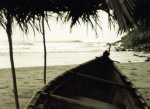
|
"Know any good jokes Joe". "Yeah, two
Irish guys driving to Chile", he responded with
a typically warm Californian smile. Talk about sending
the sheep to the wolves, the joke was precisely on us.
We had heard all the stories about the banditos, the
curvas peligrosos and the drug lords in Oaxaca. Armed
with a Spanish book, 13 surfboards and a van full of
bits and pieces, we were up for a challenge, ready for
what lay ahead. Joe wasn't so sure.
In California the idea of driving through Baja is a
radical idea in it's self. Ask somebody what they think
of driving further south and they'll tell you your nuts.
One Cali surfer had advised us to bring a flare gun.
Not to be used as a last cry for help but instead he
explained, "it's sketchy to bring a gun, so your
next best bet, is a flare gun, dude!". With a little
research of our own, my friend, David Blount and myself
had decided there had never been a safer time to take
on such a trip. There were currently no civil wars in
Central America and with the exception of government
counter insurgencies in Columbia, the Pan-American Highway
had never been more attractive. After spending 6 weeks
on the north shore of Oahu, we were soaking up the hospitality
of the Joe and Terence McNulty in San Clemente, in an
attempt to get a van and some camping gear together.
Despite the dreary outlook given by some of the locals,
San Clemente was a perfect place to get prepared. With
a budget of only a 1000 bucks, we needed a stroke of
luck to find a van that would last the 8,000 miles to
Chile. Luckily, within a few days we had met Gerry,
a hobby-mechanic who spent most of his time in Mexico,
with a van for sale. We got a great looking '79 Dodge
RAM van with a newish engine and a couple of security
tricks necessary for a road trip into Mexico. To start
the engine the old noisy bonnet needed to be lifted,
the key turned and a wire sparked off the battery. Nobody
was robbing this thing in a hurry.
Buying the van was one thing, trying to get it to pass
the Californian smog test was another. After 3 attempts
and 3 different carburetors, we took our chances with
our newly christened, 'gross polluter' and decided to
be imaginative. On the 11th of March after spending
3 weeks preparing, we were finally on our way south
and trying to get through Tijuana as fast as we could.
|
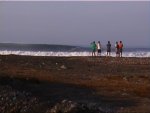
Pascuales onlookers
|
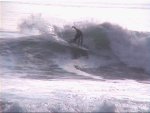
The author on a mexican right.
|

Les hombres de la playa.
|
The Baja Peninsula
Within a week we were in the southwestern tip of Baja
surfing quality waves and sleeping under a palapa (beach
hut) near Todos Santos. It's about a three day drive
from top to bottom of Baja, with the road intermittently
crossing from the pacific to the gulf side. The scenery
on the Baja peninsula is some of the most amazing you'll
see anywhere in Central America.
Between cliff-edge roads over looking the pacific near
Salsapuedes, dusty windswept desert roads of the desierto
Vizcanio and the surreal picture perfect, flat calm
of the Gulf of Mexico, Baja is an incredible introduction
to beauty of Las Americas.
Stressing about our incomplete documentation, every
military checkpoint could have been a showstopper. We
eventually came to realise, it was anything but a genuine
registration slip that these guys were looking for.
Driving at night for the first time, we met a military
checkpoint at Gurerro Negro where we were politely told
at gunpoint, to show our ID and explain our destination.
We said 'Chile'. Not looking too impressed with our
humour, the side door was opened, to be searched, so
we thought. What a mess, pulling out all those boards,
pots, lamps and car parts. In fact, it was to allow
one of the officers, who had just finished his shift,
to jump in. We were told, by way of a bunch of hand
signals to bring him and his sub-machine gun home, to
the next town about 100 miles away. 'Si como no senor'
(whatever you say sir).
As the north of Baja was still relatively cold in March,
our plan was to quickly, get to the warm water and weather
down south of Baja. We were stoked with the tips we
had received from the guys in Cali. The spare petrol
tank saved us mid-way along a dead straight stretch
of cactus lined highway, with not a gasolinera (BP station)
for 100's of miles.
Making it down south in one piece, our first real surf
was at Pescaderos just south of Todos Santos. (Not to
be confused with Isla de Todos Santos, 1000 miles north)
The water was steaming, the surf, 3 to 5 foot peaks,
breaking over a rocky bottom with only the occasional
light winds as the day heated up. The trip had finally
started and waves were on the menu, what better time
to get wet after than after 3 hard days on the road.
We stayed in this area, surfing Playa Pedrito with
a bunch of loud and funny, cerveza(beer) drinking American
surfers, where we camped for $6 a night, right in front
of the surf. Straight away we noticed how relaxed the
crowd was here, in comparison to California and Hawaii.
First thing in the morning, when it was still pretty
chilly, the surf was offshore, perfect and completely
empty for a few hours. Dave and myself took advantage
of this for the first few days. Sure enough after day
3, we were the same surfed-out, late sleeping surftrippers,
as the rest of the pack.
|
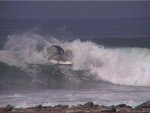
Dave Blount cuttin lose
|
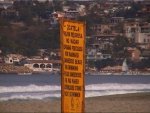
Playa peligrosa (danger)!
|
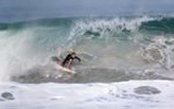
Dave in the shade, Puerto Escondido
|
Stoked with the constant swell we had gotten over the
five days we spent here, it was time to head for the
mainland via the ferry at La Paz, but first there was
some partying to be done. We were heading for Cabo San
Lucas for St. Paddy's night.
On the road east, we took an unfortunate wrong turn.
The map we had of Baja wasn't the most detailed so we
ended up on a 20-mile washboard dirt track from hell,
in the dark. Until you've driven on a surface like this,
you'll never quite understand the type of vibration
the track surface instills on the van. This was a good
training ground for what was ahead of us. Almost every
surf spot in Central America requires an intense drive
down a dusty, unpaved road leading to the surf.
Cabo, a big tourist town at the southern point of Baja,
was packed with American "spring breakers".
It being Paddy's day, we were making the most of our
Irish accents for the American girls. After lots of
cheap beer and tequila, we were heading for Valentino's
disco, until we found out was 20 bucks on the door.
With the same mentality as we would use at home, we
decided we would take the back door, by climbing up
a 10 ft cliff and jumping over the back fence. Midway
through finalising our drunken masterplan a policia
showed up with a guy who spoke English. The conversation
via the side-kick went along the lines:
"Senores, you're not supposed to be here, raise
your arms, I want to search you". Confident we
had nothing illegal, we agreed.
"Disculpe (sorry), knives are illegal in Mehico,
we're gonna have to take you in now amigos". The
policia had found a two inch swiss army knife in Dave's
pocket. We checked out this guys badge and gun. The
problem is in Mexico, there's so many different types
of police, all with different uniforms, that it's hard
to tell if they're genuine or not. Suspecting this was
a scam, but at the same time not wanting to go anywhere
near a Mexican jail, we started the negotiations:
"Is there anyway, we could pay you the fine now
and you could pay it for us later". For the first
time we had had to pull out the undisputed ticket to
ride in Mexico. Finally we got out of there after we
haggled the fine down to 40 dollars each. Bummed about
the money but not in jail with Wan Pablo and his brothers,
the next day we took the ferry to the mainland. So much
for the luck of the Irish.
|

Pascuales perfect n empty
|
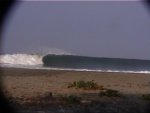
A Nexpa freighter
|
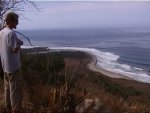
Dave checks La Ticla from above
|
Mainland Mexico - April.
On our map of Central America, we had asked a friend
in Hawaii, to pinpoint all the best spots on the mainland
coastline. He had provided us with enough insight to
enable us to make a rough plan of where we wanted to
spend most of our time. This 1500-mile stretch of coastline
from Puerto Vallarta to Salina Cruz had the most notes
written on the map. 'Peaky beach break', 'long hollow
sandbar', all the info we needed was right there. This
was where the real waves were to be found over the next
6 weeks.
April is the start of the season for well-defined swells
radiating from Southern Hemisphere. Pascuales, La Ticla,
Rio Nexpa and Puerto Escondido were all about to turn
on. After a few days spent hanging out in Puerto Vallarta,
Sayulita and San Blas, surfing waist-high waves, the
whole coastline was at an in between stage, waiting
for a swell to come from either hemisphere. We were
again planning on doing some serious drive time to get
to an underdeveloped black sand beach town, called Pascuales,
which apparently had a world famous Mexican pipe style
beach break.
It's Dave's birthday and what a surprise it is to show
up and see the 5-foot sand snarl pits at Pascuales.
Only Puerto Escondido and this place have the ability
to draw surf from an otherwise flat ocean. We booked
in at Marty's where we got the second floor of a canopy
construction which has a view of the surf, two hammocks,
mattresses and the essential mosquitores (mossie nets)
for 5 dollars.
The next morning's session was the first of a great
week spent trying to make a few barrels at Pascuales.
Waves breaking over perfectly defined sandbanks would
appear for thirty minutes, only to disappear just as
quick, with the movement of the tide. Part of a typical
day at Pascuales, is spent cleaning the sand out of
your ears and eyes after the short but brutal wipeouts.
We're practicing our basic Spanish with the school
kids, who hang out at Marty's. In return, Nacho and
Mario are around after school to borrow our surfboards.
Despite a few attempts, I'm sorry to say, this is about
the limit of our correspondence with the locales at
the moment. Next stop is to Tecoman for a beer at night
and a chance to chat to some senoritas en la plaza (the
town square). That's the meeting point for the best
well dressed senores sporting the biggest sombrero's
but more interesting to us, the finest looking senoritas.
The hours spent studying Spanish, has been great for
asking directions and ordering tacos but it hasn't yet
given us any lingo for chatting to the senoritas. We're
just spectators at this stage.
After five days with some awesome barrels racked up,
the surf has picked up to 8 to 10 feet. Standing on
the beach and watching the sets quickly reel off, we
get out to the empty line up. I'm starting to understand
why it's empty and regretting I'm not on my 8'0. I get
3 or 4 waves which all close out. By the time my last
wave washes me to the beach and breaks my board, Dave
is out the back scratching to get over the shoulder
of a triple overhead set looking into a pit from hell.
Pascuales can hold these swells but Marty, who's lived
there for 20 years, reckons the banks, pre-rain season,
hadn't had a chance to sort themselves. Either way the
next day was two foot bigger but breaking way too fast,
so we were out of here. Apparently a more sheltered
point, called La Ticla, with a right and a left, is
just an hour down the coast.
What a relief to show up and see long peeling right
and left point break waves after the intensity of Pascuales.
We arrived mid-afternoon. It was cloudy with a gusting
onshore wind and a 6-foot swell running. We paddled
out only for the wind to completely die and to be left
on our own in 40 degree midday sunshine with 200m long
walling lefts. Both La Ticla and Rio Nexpa (3 hours
further down the coast), have excellent areas to camp
and a radical mix of friendly surfers passing through.
We spent an incredible couple of weeks in La Ticla
and Nexpa, eating the freshest barbecued fish around
our campfire while sleeping comfortably in our maccas
(hammocks). The heat of the sunrise would force us out
of our sleep and into the surf each morning. The swell
seemed unstoppable, not dropping under shoulder high
once while we were along this coastline. However, the
talk around the campfire every night was about, "Puerto
dude". "Dude when ye get to Puerto, ye gotta
do this dude, ye gotta do that". Puerto Escondido
from what we had heard was the place that had it all.
Coinciding perfectly with semana santa (easter week),
the biggest and craziest party time on any Latino countries
calendar, we were Puerto bound.
|
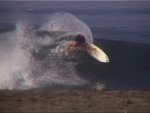
Dave rhytm at Nexpa
|
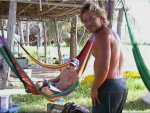
Las Palapas (camping) at Nexpa
|
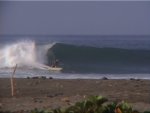
Dave again, The point at Nexpa
|
Part two will be coming at you next week.
|

